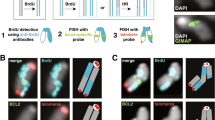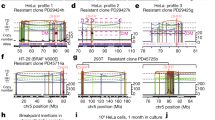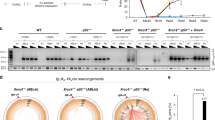Abstract
Gene amplification is frequently associated with tumor progression, hence, understanding the underlying mechanisms is important. The study of in vitro model systems indicated that different initial mechanisms accumulate amplified copies within the chromosomes (hsr) or on extra-chromosomal elements (dmin). It has long been suggested that formation of dmin could also occur following hsr breakdown. In order to check this hypothesis, we developed an approach based on the properties of the I-SceI meganuclease, which induces targeted DNA double-strand breaks. A clone containing an I-SceI site, integrated by chance close to an endogenous dhfr gene locus, was used to select for methotrexate resistant mutants. We recovered clones in which the I-SceI site was passively co-amplified with the dhfr gene within the same hsr. We show that I-SceI-induced hsr breakdown leads to the formation of dmin and creates different types of chromosomal rearrangements, including inversions. This demonstrates, for the first time, a direct relationship between double-strand breaks and inversions. Finally, we show that activation of fragile sites by aphidicolin or hypoxia in hsr-containing cells also generates dmin and a variety of chromosomal rearrangements. This may constitute a valuable model to study the consequences of breaks induced in hsr of cancer cells in vivo.
This is a preview of subscription content, access via your institution
Access options
Subscribe to this journal
Receive 50 print issues and online access
$259.00 per year
only $5.18 per issue
Buy this article
- Purchase on Springer Link
- Instant access to full article PDF
Prices may be subject to local taxes which are calculated during checkout





Similar content being viewed by others
References
Balaban-Mallenbaum G, Grove G, Gilbert FW . 1981 Cancer Genet. Cytogenet. 2: 339–348
Brison O . 1993 Biochem. Biophys. Acta 1155: 25–41
Brizel DM, Scully SP, Harrelson JM, Layfield LJ, Bean JM, Prosnitz LR, Dewhirst MW . 1996 Cancer Res. 56: 941–943
Carroll SM, DeRose ML, Gaudray P, Moore CM, Needham-Vandevanter DR, Von Hoff DD, Wahl GM . 1988 Mol. Cell. Biol. 8: 1525–1533
Coquelle A, Pipiras E, Toledo F, Buttin G, Debatisse M . 1997 Cell 89: 215–225
Coquelle A, Toledo F, Stern S, Bieth A, Debatisse M . 1998 Mol. Cell 2: 259–265
Dujon B . 1989 Gene 82: 91–114
Fang JM, Arlt MF, Burgess AC, Dagenais SL, Beer DG, Glover TW . 2001 Genes Chromosomes Cancer 30: 292–298
Gisselsson D, Pettersson L, Hoglund M, Heidenblad M, Gorunova L, Wiegant J, Mertens F, Dal Cin P, Mitelman F, Mandahl N . 2000 Proc. Natl. Acad. Sci. USA 97: 5357–5362
Graeber TG, Osmanian C, Jacks T, Housman DE, Koch CJ, Lowe SW, Giaccia AJ . 1996 Nature 379: 88–91
Hellman A, Zlotorynski E, Scherer SW, Cheung J, Vincent JB, Smith DI, Trakhtenbrot L, Kerem B . 2002 Cancer Cell 1: 89–97
Jasin M . 2000 Cancer Invest. 18: 78–86
Kinzler KW, Vogelstein B . 1996 Nature 379: 19–20
Knudson AG . 2000 Annu. Rev. Genet. 34: 1–19
Krummel KA, Roberts LR, Kawakami M, Glover TW, Smith DI . 2000 Genomics 69: 37–46
Le Beau MM . 1986 Blood 67: 849–858
Luk CK, Veinot-Drebot L, Tjan E, Tannock IF . 1990 J. Natl. Cancer Inst. 82: 684–692
Ma C, Martin S, Trask B, Hamlin JL . 1993 Genes Dev. 7: 605–620
McClintock B . 1942 Proc. Natl. Acad. Sci. USA 28: 458–463
Nowell PC, Rowley JD, Knudson AG . 1998 Nat. Med. 4: 1107–1111
Perucca-Lostanlen D, Hecht BK, Courseaux A, Grosgeorge J, Hecht F, Gaudray P . 1997 Cytogenet. Cell Genet. 79: 88–91
Pipiras E, Coquelle A, Bieth A, Debatisse M . 1998 EMBO J. 17: 325–333
Rice GC, Hoy C, Schimke RT . 1986 Proc. Natl. Acad. Sci. USA 83: 5978–5982
Richards RI . 2001 Trends Genet. 17: 339–345
Richardson C, Jasin M . 2000 Nature 405: 697–700
Rouet P, Smih F, Jasin M . 1994 Mol. Cell. Biol. 14: 8096–8106
Ruiz JC, Wahl GM . 1988 Mol. Cell. Biol. 8: 4302–4313
Saunders WS, Shuster M, Huang X, Gharaibeh B, Enyenihi AH, Petersen I, Gollin SM . 2000 Proc. Natl. Acad. Sci. USA 97: 303–308
Schwab M . 1999 Semin. Cancer. Biol. 9: 319–325
Singer MJ, Mesner LD, Friedman CL, Trask BJ, Hamlin JL . 2000 Proc. Natl. Acad. Sci. USA 97: 7921–7926
Smith DI, Huang H, Wang L . 1998 Int. J. Oncol. 12: 187–196
Smith KA, Gorman PA, Stark MB, Groves RP, Stark GR . 1990 Cell 63: 1219–1227
Smith KA, Stark MB, Gorman PA, Stark GR . 1992 Proc. Natl. Acad. Sci. USA 89: 5427–5431
Sutherland GR, Baker E, Richards RI . 1998 Trends Genet. 14: 501–506
Toledo F, Buttin G, Debatisse M . 1993 Curr. Biol. 3: 255–264
Toledo F, LeRoscouet D, Buttin G, Debatisse M . 1992 EMBO J. 11: 2665–2673
Trask BJ, Hamlin JL . 1989 Genes Dev. 3: 1913–1925
Windle B, Draper BW, Yin Y, O'Gorman S, Wahl GM . 1991 Genes Dev. 5: 160–174
Yunis JJ . 1983 Science 221: 227–236
Acknowledgements
We thank Drs M Weiss and G Buttin for careful reading of the manuscript and helpful discussion, B Dujon for providing the I-SceI gene and the protein recognition sequence, J Hamlin for the cosmids of the dhfr locus. This work was supported in part by the Association pour la Recherche sur le Cancer, the Fondation de France, the Ligue Nationale Française contre le Cancer (Comité de Paris). A Coquelle is supported by a fellowship of the Ligue Nationale Contre le Cancer and L Rozier is a Fellow of the MENRT.
Author information
Authors and Affiliations
Corresponding author
Rights and permissions
About this article
Cite this article
Coquelle, A., Rozier, L., Dutrillaux, B. et al. Induction of multiple double-strand breaks within an hsr by meganucleaseI-SceI expression or fragile site activation leads to formation of double minutes and other chromosomal rearrangements. Oncogene 21, 7671–7679 (2002). https://doi.org/10.1038/sj.onc.1205880
Received:
Revised:
Accepted:
Published:
Issue Date:
DOI: https://doi.org/10.1038/sj.onc.1205880
Keywords
This article is cited by
-
The genomic and spatial mobility of extrachromosomal DNA and its implications for cancer therapy
Nature Genetics (2022)
-
Life of double minutes: generation, maintenance, and elimination
Chromosoma (2022)
-
Generation and maintenance of acentric stable double minutes from chromosome arms in inter-species hybrid cells
BMC Molecular and Cell Biology (2019)
-
Tumor hypoxia as a driving force in genetic instability
Genome Integrity (2013)
-
Gene amplification in human cells knocked down for RAD54
Genome Integrity (2011)



